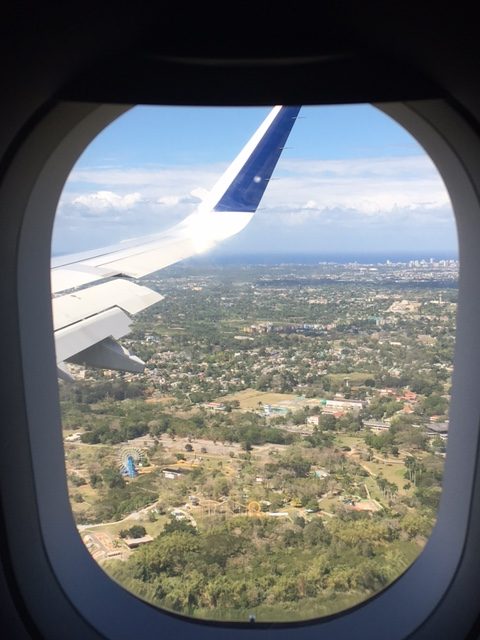
Cuba, si! That was our battle cry, fists pumping the air, as seven of us boarded Jet Blue’s Flight 1499 from Fort Lauderdale to Havana. Our excitement was palpable and obvious.
But beneath it lurked misgivings that we, parents in our sixties, were traveling with our 27-year-old daughter and four of her friends to a country that was completely unknown to most Americans until Jet Blue’s first commercial flight to the island on August 31, 2016, the first in 55 years. Flight 387. We were concerned we might be chasing the twentysomethings, none of whom spoke Spanish, all around Havana as they partied the nights away. Cuba, after all, is still a communist country, with spotty WiFi and Internet connections, and if they got lost or into trouble, it wasn’t as if they, like E.T., could call home.
As it turned out, Havana at any hour of the day or night is probably safer than most large cities in the U.S. The Cuban people are gracious and accommodating and deeply grateful to President Obama for opening a door between their country and ours that had been shut for more than 50 years. And the twentysomethings taught us a few things about traveling on the wild side without spending a fortune!
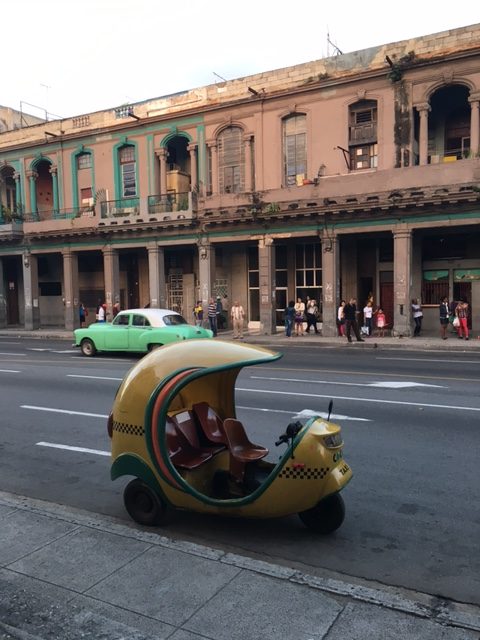
The island had been closed to Americans since the embargo began in 1962 but the door opened again in December 2014, when Obama and Raul Castro announced they would re-establish diplomatic relations.
Our Jet Blue Flight 1499 departed Fort Lauderdale on the morning of February 23. We left our house at 8 a.m., drove the hour to Lauderdale, found parking in the economy parking lot at the airport, took a shuttle to the Jet Blue terminal, and arrived two hours before our 12:14 p.m. flight. We traveled under two categories – humanitarian and in support of the Cuban people, a category Obama added, broad enough to support most American travel to the island. Erin, who works with dolphins at Sea World, brought a large supply of food and medicines for an animal shelter on the island, so she qualified under the humanitarian category.
Going through check-in at the Lauderdale airport was a breeze. We encountered no resistance or questioning whatsoever. The cost of the ticket includes health insurance in Cuba. We each paid a $50 visa fee that covered us round trip. Jet Blue allows you to check one bag for free and to carry two personal items on board at no cost. The round trip ticket was $150 from Lauderdale and $120 for Nick, who joined us on Friday, February 24. The only glitch is that you can’t check in online.
The day before, we had exchanged American dollars to Canadian dollars because Cuba imposes a 10 percent surcharge on American dollars plus a 3 percent tax. We got the best deal at a local travel agency, which charged us only $5 for the exchange. The American dollar is the only currency that is penalized in that way – probably a result of a 55 year embargo. Cuban currency is two fold – CUPs for locals and CUCs for visitors. By exchanging Canadian dollars, we bypassed that 10 percent surcharge.
Once we were in the air, the flight was just 33 minutes. When we landed, the pilot announced in perfect English and Spanish Welcome to Cuba! And everyone on board applauded. Imagine it – 33 minutes and you’re in a foreign country!
Jose Marti Airport was jammed with tourists that morning. Multiple lines at immigration, more lines at customs.
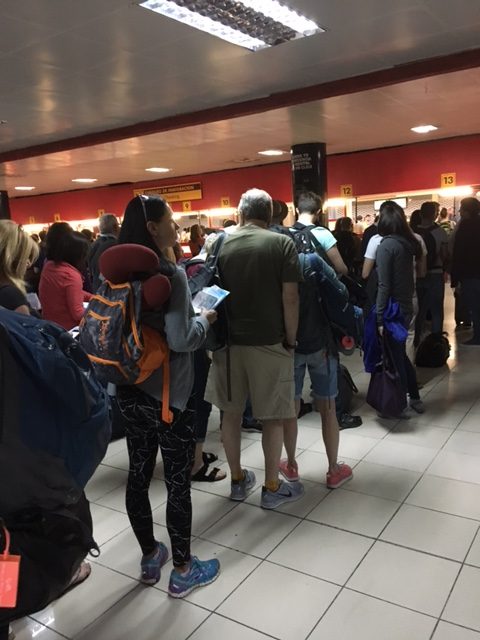
We slipped into a short line and were out of there within 45 minutes. Our host, Jose, had arranged a pickup for us – two cars because Cuban cars are typically small and don’t accommodate more than 4 people.
We walked out into the main area, where many locals were holding signs for the people they were picking up and wandered round, looking for someone who held a sign that read, Casa Jose, the casa particular – private home or apartment – where we were staying. Rob finally found a woman with that sign. Maria, a friend of Jose’s, and her husband, Roberto, led us through the crowd to their taxis. Only official taxis in Cuba are permitted to carry foreigners to and from the airport and the fare per taxi is standard, set by the government – 25 CUCs. Here’s the first thing we saw as we walked outside:
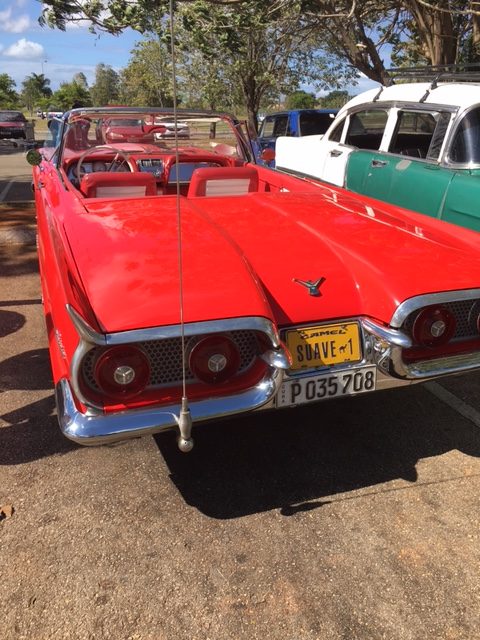
Maria was terrific- informative, immediately a compadre, pointing out interesting landmarks. There, she said, is the stadium where the Rolling Stones put on a free concert a couple years back and people from all over the world came – except for Americans, unless they went through Mexico. And down that street in old Havana is where Hemingway drank with the likes of Ezra Pound, Graham Greene, and Pablo Neruda. Stuff like that.
But our first order of business was more practical – exchanging our money to CUCs, which we finally did, at a local bank. This, like everything else in Cuba, was an adventure. Banks and the Casas de Cambio – money exchange houses – are strange creatures. At the doorway of these places stands one person – usually a man in uniform who is part of a special agency in Cuba that does only this. One or two people are allowed inside the building at a time. You show your passport, your $, identify the type of currency – and they tell you the exchange rate.
If you don’t speak Spanish, however, you’re at a disadvantage. Because the country is so poor – average government workers make between $20-40 a MONTH – there may be some slight of hand, magician tricks. It happened to two people in our group.
Our host, Jose, who owns Casa Jose where we stayed, walked us to and from the bank, through fascinating neighborhoods of crumbling buildings and open doorways that led up dark, mysterious staircases to lives I can’t imagine. Yet, there’s a certain spirit of joy that flourishes in this city. I was struck by the general happiness and joy of the Cuban people, who go about their lives like the rest of us, but with a vivid, subterranean awareness that they can’t leave the island.
You don’t see boats in the harbor – not even fishing boats – because people aren’t allowed to fish in boats. The government controls the fishing industry. You can cast with a rod and reel from the seawall along the malecon– the five-mile stretch of boardwalk that borders the Caribbean- but you can’t climb over that wall, to the rocks and water below, to the freedom that lies less than a 100 miles from where you stand.
The thirst and hunger for that freedom is palpable. In fact, the perfect metaphor for this hunger for freedom, for the complexity of Havana and Cuban life, is this exquisite spiral – a staircase of a restaurant, El Biky, where we ate our first night in Havana:
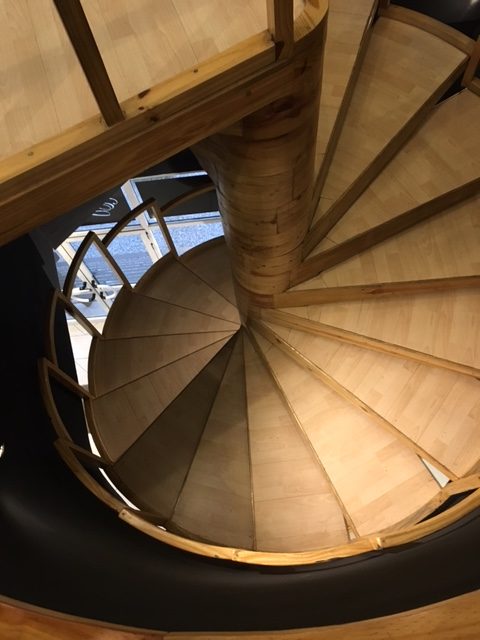
Stay tuned for part 2.








Great! Waiting for part 2…and 3…and 4….and 5……
Just 33 minutes away – you can go every weekend. 🙂 I am reminded of one of my favorite movies, “Guys and Dolls” with Marlon Brando and Frank Sinatra where Brando takes “the doll” to Havana for the evening.
All sounds wonderful – and only 33 minutes flight! I can imagine you have many tales to tell, so look forward to part 2.
Wow! I love it and can’t wait for part 2. Well, I can and am already looking forward to it. Wonderful and informative post. The pictures are great, too. 🙂